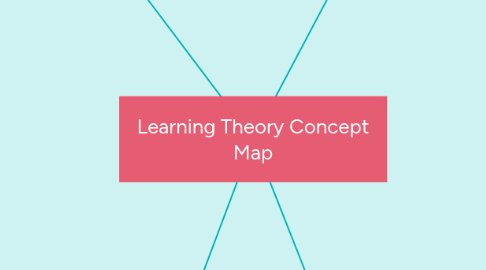
1. Social Constructivist Learning Theory
1.1. Theorist
1.1.1. Lev Vygotsky
1.2. View of Knowledge
1.2.1. Knowledge is a collaborative experience that is developed through social interactions and language use.
1.2.2. Knowledge is co-constructed.
1.3. View of Learning
1.3.1. That learning occurs within the Zone of Proximal Development
1.3.1.1. The Zone of Proximal Development considers the distance between the student can do independently to what the student can do with guidance from an adult/expert
1.3.1.2. Students can then master concepts and ideas they normally cannot understand alone.
1.3.2. Learners learn best working collaboratively with those at a higher proficiency level than their own to complete tasks that they are not able to do independently
1.4. Theory informs learning
1.4.1. Through the Zone of Proximal Learning, the teacher provide guidance through scaffolding, guided participation, and intersubjectivity.
1.4.2. Learning is more student-centered where teachers act as facilitators to guide/assist student understanding
1.4.3. Student at different proficiency level are pair up to build meaningful social interactions in order to better inform their learning experiences
2. Humanistic Learning Theory
2.1. Theorist
2.1.1. Abraham Maslow
2.2. View of Knowledge
2.2.1. Focuses on the whole person who are driven by both their feeling and intellect rather than one or the other.
2.2.2. Humans are inherently good and will make good decisions when all their needs are met; according to Maslow's hierarchy of needs
2.3. View of Learning
2.3.1. Learners can be trusted to make their own goals, standards, and evaluate their own work.
2.3.2. Learning is a way to fulfill an individuals potential- to reach self-actualization
2.4. Theory informs learning
2.4.1. Learning is student-centered and personalized
2.4.2. Teachers are facilitators/role models who support the academic and social development of learners
2.4.3. Teachers help students provide choice, teach learning skills, provide motivation, and create opportunities for group work with peers
3. Transformative Learning Theory
3.1. Theorists
3.1.1. Jack Mezirow
3.2. View of Knowledge
3.2.1. Thinking can be adjusted based on new information- world view changes as we learn
3.2.2. Meaning structure, which is the concept judgement, and feelings that shape a persons knowledge and experiences, is understood through self-reflection.
3.3. View of Learning
3.3.1. Learners are constantly evaluating past knowledge and critically reflecting to acquire new knowledge
3.3.2. This is described in 10 transformative phases
3.3.2.1. Disorienting Dilemma - recognizing that past knowledge do not match current experiences; cognitive dissonance
3.3.2.2. Self-Examination - self-reflect upon the connection between past experiences and the disorienting dilemma
3.3.2.3. Critical Assessment of Assumptions - Critically review past assumptions and acknowledge faults and gaps in prior experiences
3.3.2.4. Planning a course of action - a perspective change where learners develop a strategy to fill those gaps to better understand the problem/situation
3.3.2.5. Exploring new roles - to understand new roles, relationships and actions that are compatible with the perspective change
3.3.2.6. Acquisition of knowledge/skill - learn a new skill/knowledge to carry out plan
3.3.2.7. Trying New Roles - actively apply new knowledge/ skill in identify roles/relationship/actions that were compatible to perspective change.
3.3.2.8. Building Confidence - Through gaining new experiences/making decisions, learners can build self-awareness and confidence
3.3.2.9. Reintegration - Acclimate to new perspective and move forward with our lives.
3.4. Theory informs learning
3.4.1. Provide learners a chance to learn about different/new perspectives
3.4.2. Encourage critical analysis by identifying and questioning learners assumptions
3.4.3. Teachers can serve as facilitators to create student discourse/ critical discussions
4. Social Learning Theory
4.1. Theorists
4.1.1. Albert Bandura
4.2. View of Knowledge
4.2.1. knowledge and social behavior is gained through observation and modeling of others
4.3. View of Learning
4.3.1. 4 Elements that describe the mediation process leading up to the modeling of others; observational learning
4.3.1.1. Attention: focusing on something different or unique helps with learning
4.3.1.2. Retention: learners internalize information and recall it for use in a later situation
4.3.1.3. Reproduction: recalling the act and performing the behavior that was observed
4.3.1.4. Motivation: a reinforcement that encourages the need to imitate the behavior that was modeled
4.4. Theory informs learning
4.4.1. Utilize reward system to encourage others to observe and model the expected classroom behaviors
4.4.2. Provide positive reinforcement motivates learners to repeat the behavior that lead to the positive reinforcement
4.4.3. Teachers can guide students using this theory to focus their energy towards learning
